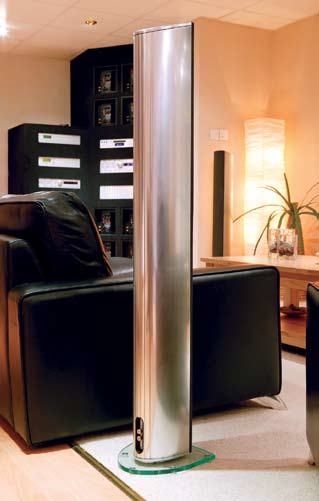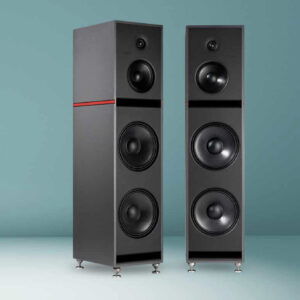
About a year ago Definitive Technology President Sandy Gross called me, sounding excited. “I wanted to tell you we’re working on a new kind of Super Tower speaker that will use a variation on those mid-bass drivers you liked so much in our ProCinema 1000 system. We’re going to call it the Mythos ST.”
The $1649 ProCinema 1000 rig, which I reviewed in The Absolute Sound issue 168, featured mid-bass drivers so sophisticated they would not have seemed out of place in costly high-end stereo speakers. I had often wondered what would happen if Definitive applied those drivers in a more ambitious speaker.
“So the new speaker is going to be a Super Tower and a Mythos model at the same time?”
“Yes,” Sandy replied. “It will be a slender floorstander with an aluminum enclosure, taller and deeper than past Mythos models, but styled to have the traditional Mythos look. Each ST will have a forward-firing, D’Appolito array on top, and a powered subwoofer on the bottom. And each one will have the same bass output as one of our SuperCube subwoofers.”
“How will SuperCube drivers fit inside a Mythos enclosure?”
“Oh, they won’t,” said Sandy. “The ST cabinet is too narrow for traditional round woofers. Instead, we’ve designed ‘racetrack’-shaped woofers and passive radiators just for this speaker, and we’ll drive them with built-in 300-watt amps.”
“Are you doing a new tweeter, too?” I asked the question because Definitive’s past aluminum-dome tweeters, though good, were not in the same league as its superb midbass drivers.
“Sort of,” Sandy said. “We’ve revamped our tweeter, tweaking lots of design elements to cut non-linear distortions in half. I think the new ones sound much better, but you can judge for yourself when you hear them.”
I first heard the Mythos ST ($3798/pair) at CES 2007 and three things impressed me from the outset. First, the speaker offered terrific amounts of low-level detail and high frequency “air” coupled with an underlying quality of treble smoothness. Second, it reproduced depth and imaging cues in an effortless way, so that palpable images broke free from the speaker cabinets in a convincing way. Third, it delivered bass that was powerful, tightly controlled, and fast. In short, the Mythos ST struck me as being hands down the best-sounding speaker Definitive has yet made—and one that arguably establishes performance benchmarks in its price class. I considered doing an immediate review of the speaker, but decided to wait unit the companion Mythos Ten center channel came out, so that I could test a complete Mythos ST surround sound system. And now that I’ve heard that system, I can confidently say its performance puts many higher priced rigs to shame.
The Rest of the System
The Mythos Ten essentially takes the D’Appolito array section of the ST, flips it on its side, then stretches the chassis just enough to fit in a pair of oblong passive radiators similar to, but smaller than, those used in the ST. The Ten’s bass won’t go as low as the STs’ does, but in all other respects its voicing is identical to its bigger brother. This means you’ll hear seamless speaker-to-speaker transitions as sound effects pan across the front channels.
Completing the system are a pair of compact Mythos Gem XL surround-speakers, also based on two-way D’Appolito arrays. Because the XLs are an earlier generation design, their drivers aren’t quite as sophisticated as those in the STs and the Ten. Even so, the Gem XLs would qualify as main speakers in most systems, meaning they’re more than adequate for surround applications.
Performance
The Mythos ST surround system draws together three essential sonic qualities—resolution, dynamics, and 3D imaging—that add up to a fourth: a touch of pure magic. Let me explain what that comment means in practical terms.
On film soundtracks, the ST system produces an articulate, neutrally-voiced and decidedly muscular sound that absolutely takes command of most listening rooms. In the initial chase scene from Terminator III: Rise of the Machines, a deadly robotic Terminatrix (Kristanna Loken) drives a motorized crane, pursuing John Connor (Nick Stahl) and his spouseto- be (Claire Danes) through crowded city streets. The ST system reproduced the ensuing mayhem of the crane ripping through phone poles, cars, and even buildings with terrific vigor and dynamic impact. Yet even through the thickest action-film soundtracks the ST system never loses sight of two essential qualities: overarching clarity and low-level detail.

At one point in the chase, for example, the evil Terminator (Loken) attempts to dispose of the good-guy Terminator (Schwarzenegger) by dragging him through the cab of an oncoming fire truck. Through many speaker systems the resulting collision produces nothing more than a generic loud noise, but the ST system—thanks to its superb detail and pitch definition— lets you hear the unmistakably metallic “claaAANK” of the heavy-metal Schwarzinator plowing into the nose of the truck.
Similarly, in the final shootout scene from Open Range, the ST system displays raw power (delivering the ear-splitting “craaccKK” of individual gunshots) as well as impressive textural subtlety. You can, for instance, hear the ratcheting “clicks” of Colt revolvers being cocked, the sharp “whirr” of shards of wood sizzling through the air as shots go astray, or the gently modulated moan of the prairie wind in the background. The point is that the Definitive system weaves together small, seemingly inconsequential details to create a fabric of sheer realism.
But superb though the Mythos ST system is in home-theater contexts, it is really at its best when reproducing music—and the higher the resolution the better. In fact, the biggest “problem” you might encounter with the Mythos ST system could be finding electronics, source components, or recordings good enough to tap its full potential.
Let’s start with the basics. The ST system is sensitive and easy to drive, in part because its built-in powered subwoofers shoulder the lion’s share of the bass workload—you don’t need to use high-powered amplifiers unless you want to. (Definitive’s Sandy Gross, for example, drives his personal pair of Mythos STs with a modest, 17Wpc tube amplifier). Further, the ST system offers smooth, neutral tonal balance; delicate and extended highs; deep, powerful, and lightning-fast bass response; and the ability to resolve very fine levels of sonic detail. And therein lies the genius, but also the only potential drawback, of this system.
The good news is that the ST system resolves subtle textural and dynamic details more effectively than other systems its price. For instance, the ST shows how subliminal outdoor sounds—birds and insects chirping or the rustle of a soft passing breeze—contribute tremendously to the pastoral vibe of “The Park” from Feist’s The Reminder [Cherrytree/Interscope]. But the not-always-good news is that the Definitive rig sometimes exposes shortcomings in associated equipment or recordings. For example, the ST system shows how Feist’s vocals vary in sound quality from track to track, ranging from dreamy smoothness on “How My Heart Behaves” to a raw, hard-edged sound on the closing chorus of “The Park.” For better or worse, the ST system faithfully reports whatever it “hears.”

When recording quality is spot-on, as on Sara Hickman’s luminous vocals on “In the Fields” from Shortstop [Elektra], the ST system becomes downright holographic, its rich details and overall sense of “air” bringing vocals, instruments and even the recording space to life in a vivid way. And thanks to Definitive’s revamped tweeters, treble details always remain smooth (a step forward from past Definitive tweeters, which occasionally became a bit rough or coarse). Bass textures and transients likewise exhibit clarity, punch and speed. Listen to a recording that showcases acoustic bass, such as the Blue Chamber Quartet’s arrangement of the Astor Piazzolla composition “Kicho” [First Impressions, Stockfisch SACD], and you’ll be floored to hear how this system captures the size, weight, and tightly-focused growl of the instrument. The STs simply don’t do bass boominess, and the longer you listen the more you’ll appreciate their lithe, accurate bass.
The system exhibits few performance drawbacks, and those that arise almost always result from excessive volume settings (a serious temptation, given how gracefully the system plays at loud levels). On loud, prolonged pipe organ passages and the like, the subwoofer can be overdriven, resulting in momentary, atonal “chuffing” sounds. Similarly, at very high levels the mid/bass drivers can exhibit hints of upper midrange forwardness that bespeak strain. But at sane volumes, the system rarely breaks a sweat.
Let me also offer two small performance tips. First, check periodically to make sure the speakers’ metal floor spikes remain firmly tightened into the granite floorplates; you’ll hear some “buzzing” if the spikes happen to work loose. Second, in home theater systems, run speaker cables to the STs as you normally would, but also route line-level subwoofer signals to the speakers’ dedicated LFE inputs. This easy-to-overlook setup touch will give the system fuller, better balanced bass on movie soundtracks.
Tags: LIST






















